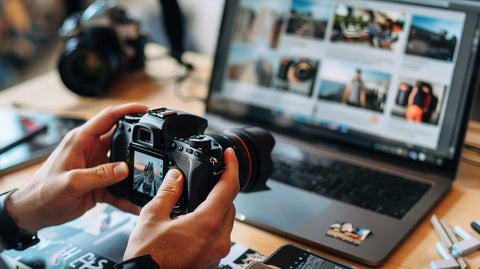- Lightroom Presets
- Mobile Presets
-
Photoshop
-
Learn
-
Support
-
Install
- Best Sellers
- Blog
By Zach Egolf on | No Comments

A new year means a few new things to a photographer; new clients, new bookings, and most importantly the chance to review the tools with which we hone our craft to evaluate whether we need new equipment!
The landscape of cameras grows nearly every single day, and it can be a bit overwhelming trying to figure out what’s out there, what’s going to give you the best bang for your buck, and what you might need to help take your photography to the next level!
We know how tough of a decision it can be to pick the right camera, so we’ve put together this camera guide to help you with your process!
For the purposes of our evaluation, we’ve separated our list into three categories, selected a few cameras from each level, and added them to our list based on the standard concept of camera levels:
Consumer - These are generally considered to be entry-level cameras. You will probably end up losing some of the features that are more important to professionals but will end up gaining a bit of convenience because these cameras will fall closer in-line to the “point and shoot” varieties. That’s not to say that they’re bad cameras, just don’t expect to be able to tweak every setting under the sun.
Prosumer - These cameras will be mid-range as far as both price and feature-sets. Cameras in the prosumer level have a lot more features than the consumer level, but might not necessarily break the bank. These are cameras that might be full frame, but have a lower megapixel count, or lack some features such as FPS, or weather-proofing. Nine times out of ten, if you want to have a photography business, but are just starting out, these cameras are going to be great.
Professional - These cameras are going to be the big dogs. Big in price, big on features, and probably big on learning curve too. Heck, they might even actually be physically big, as well! These cameras are going to cost you a few wedding’s worth of income, but they’ll be more of an investment, akin to a really nice piece of glass (lenses). Expect lots of features, lots of bells, and lots of whistles!
So, without further ado, let’s get to our list!

Without a doubt, whenever a photographer thinks “Consumer-level camera” they’re probably talking about the Canon Rebel line. Long has been the history of Canon’s Rebel line when it comes to introductory level cameras, and the Canon Rebel T7i is no different. You’re going to get a great little camera by purchasing this, with some really great entry-level specs!

Improvements continue to be made in the mirrorless camera market, and Sony’s Alpha line of cameras is definitely one to check out. The a6000 has been around for a couple of years, but it’s still a really great little workhorse, and with the price having dropped to below $500 with a 16-50mm Power Zoom Lens, it’s almost an impulse buy! (Hey, I said almost)
Sony’s Alpha mirrorless cameras are compact, but pack a punch, and will be great to throw in a bag for a quick engagement session, or just to take some quick photos of your kiddos or doggies!

Nikon’s D7200 ramps up the production value quite a bit, taking photographers from the entry-level point-and-shoot quality of consumer cameras, to a quality that gets you closer to a pro. Nikon calls the D7200 the “the star of Nikon's DX-format line-up” and gives it plenty of reasons to back that up.
With a lot more features than a consumer body, if you’re firmly implanted in “Camp Nikon” and looking to upgrade from something more low-level (like the Nikon D3400), then you’ll certainly want to check out the D7200!

I waffled back and forth on recommending the 6D Mark II over something like the 7D Mark II, but if this is your first foray into Prosumer level cameras, the 6D Mark II is a solid choice. Most importantly, this camera is going to be your first introduction to “full frame photography” which is the oft-touted “secret” to becoming a professional (spoiler alert: it’s not that important). This version is an iterative update to the original 6D, so if money is a concern, you may want to consider looking for a slightly used, well-taken-care-of original model. That being said, The 6D Mark II is going to give you a few good years worth of body and is definitely worth the money.

Ready to spend some money? Welcome to the world of “Professional Photographer Cameras! Leading the pack is the Nikon D850. Now personally, I’m a Canon shooter, but the Nikon D850 is such a beast of a machine - if I had a spare $3000 sitting around this camera would almost be enough to sway me to switch brands. This thing has it all. 45 megapixels worth of a sensor, 9 frames-per-second, and is capable of shooting 4K UHD video. On top of that, it has the lowest base ISO of any DSLR or mirrorless camera on the market! This body is going to be an investment, and it’s going to be worth every penny you spend!

Canon’s powerhouse is the Canon 5D Mark IV. You’ll notice right off the bat that this is lacking some of the stuff found in the Nikon D850, but if you’re already in the Canon family, this is going to be your go-to professional camera. It features a 30.4 MP full-frame CMOS sensor capable of shooting 4K video and a 61-point AF system with 41 cross-points for expanded vertical coverage. It’s a step up from any other DSLR that Canon makes, and should last you a few years with the right lenses attached to it. If you’ve ever used a Canon 5D camera, you’ll know the legacy that this body has to follow, and it does so with splendor and grace.

Sony continues to do amazing things with their mirrorless cameras, and the a7R III is a specimen to behold. It’s the camera that continues to intrigue me almost enough to leave traditional DSLR cameras behind to go into the mirrorless light. It sports a 42.4 MP back-illuminated Exmor R CMOS sensor with gapless on-chip lens design and can shoot 10 fps with continuous and accurate AF/AE in either mechanical or silent shutter mode. The a7R III will even shoot 4K2 HDR3 video, putting it in direct competition with the Nikon D850! If you’re not tied to Nikon or Camera, you should really give the Sony a7R III a strong look as a contender in the professional field.
Read more about Full Frame vs. Crop Sensor Cameras here!
And if you are looking for a new camera lens, here is a great article to help you find the best lens to purchase!
Do you have any questions or comments about any of the cameras mentioned here? Leave us a comment below - we would LOVE to hear from you! And PLEASE SHARE our camera buying guide using the social sharing buttons (we really appreciate it)!




Zach began his photography career shooting local sports, later transitioning into wedding and family photographer. It was here that he really honed his craft, creating countless priceless memories for folks both young and old.
When not at his full-time job, Zach spends his time with his beautiful wife, wonderful new son, and fantastic dog, all while still finding time to capture the wonderful memories experienced by families as they go from couples, to spouses, to new parents, and beyond.

Comments